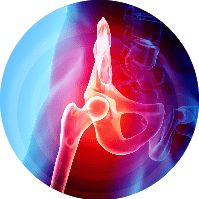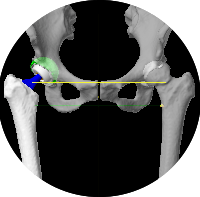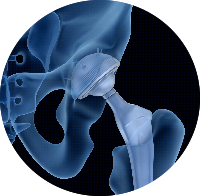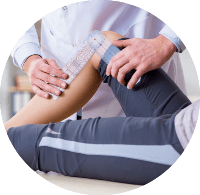ROBOT-ASSISTED HIP REPLACEMENT PERTH
Patient overview:
Robotic Hip Replacement Surgery –
Explanation, advantages, pain management, rehabilitation & risks.
Australian Academy of Robotic
Orthopaedic Surgeons
Robot-Assisted Hip Replacement Specialists
Robotic Hip Replacement Surgery
The information presented is for educational purposes only. Individual results vary. Speak to your doctor about the surgical advantages and risks to decide if robotic joint replacement surgery is right for you.
*To view all references and statistics visit – Stryker.
What is Total Hip Replacement Surgery?
What is Total Hip Replacement Surgery? – Total Hip Replacement Surgery involves replacing a damaged or worn hip with an artificial hip joint called a prosthesis.
Hip replacement prothesis can be of metals such as stainless steel and titanium, ceramics, highly engineered polyethylenes and cements made of acrylic polymer.
A common hip replacement procedure takes 1-2 hours and may consist of:

Robot-Assisted Hip Replacement Surgery
Advantages of Robot-Assisted Hip Replacement Surgery
The MAKO Technology and Robotic-Arm allows for:
*MAKO Robot-Assisted technology research data
Mako data shows it has a lower revision rate than the same components implanted using any other hip replacement techniques.
Evidence also exists to show patients undergoing MAKO Robot-Assisted Hip Replacement commonly have:
Pain Management
After Robot-Assisted Hip Replacement Surgery
Patients may still experience some mild discomfort. Most patients are generally encouraged to stand and walk within hours of surgery. Please report your pain levels and discomfort to the nursing staff.
In recent years Anaesthetists who specialise in pain management and control have substantially improved pain management in relation to Hip Replacement surgeries.
There have been major advancements in multi-modal pain management techniques that substantially reduce the pain discomfort from surgery and post-operative recovery. When combined with the post-operative data of MAKO Robot-Assisted Hip Replacement technology patients may experience less pain and require less post-operative pain medication as a result in less soft tissue ‘cutting’ which translates to less pain.
A pain management plan will be discussed with you in depth before and after your operation to ensure you are comfortable throughout your recovery and rehabilitation.
How Long Will it Take to Recover from Robotic Hip Surgery?
Recovery times may vary from patient to patient for a number of reasons including age, current heath, muscle and bone strength and commitment to rehabilitation amongst many other factors.
Moving post surgery – Most patients may be able place some weight on the hip and walk with assistance (when safe to do so) 4-6 hours after surgery. Movement and slight weight bearing on your hip soon after surgery is encouraged.
Physiotherapy recovery program – You will see a physiotherapist and be prescribed a rehabilitation program after your surgery. Prior to discharge you will be given exercise instructions and practice on how to best perform daily activities including climbing stairs, getting into and out of cars etc.
Hospital stay length – Your hospital stay is usually 1-3 days. It may be longer depending on your individual circumstances.
Movement after surgery – Moving around with crutches is recommended for the first two weeks for comfort, safety and confidence. The crutches can be discarded as soon as you are confident to do so.
Will I need time off work – Depending on occupation you may require 2-6 weeks off work. You can be driven in a car as a passenger immediately on discharge from hospital.
Driving – Patients managed by anterior approach surgery can drive a car when they feel confident but no earlier than 2 weeks after their surgery (4 weeks for posterior approach surgery). Patients MUST be able to perform an Emergency Stop and short car trips only are recommended initially. The decision to drive after surgery remains the responsibility of the patient.
Air travel – Air travel may be undertaken soon after you are cleared by your surgeon.
Robotic Hip Replacement Perth – Rehabilitation
Rehabilitation is a major element in determining a successful outcome of Hip Replacement Surgery. Rehabilitation is driven by physiotherapist professionals and the hard work and dedication of the patient to get back to normal activities as fast as possible. The rehabilitation process starts the day of the surgery and is an ongoing process for at least 6 months.
The rehabilitation program may help with:
Your hip rehabilitation program will be discussed in depth with your surgeon and physiotherapist and designed to meet your specific needs and concerns.
What Activities can I Return to After Rehabilitation?
What activities can you perform after a Total Hip Replacement Once recovered and rehabilitated, there are very few restrictions on activity after a Total Hip Replacement. You can participate in activities such as walking, cycling, skiing and tennis.
Some activities may place the joint replacement at risk (for example extremes of joint flexion and rotation in some advanced yoga postures) – if you are unsure please check with us prior to recommencing your desired activity.
Running and impact sports – High impact pursuits such as running cannot be performed for 6 months after surgery. Your suitability for returning to running activities depends on the nature and intensity of the sport you are undertaking and the type of prosthetic implant you have.
Hip monitoring – Monitoring how your hip replacement performs overtime is essential to ensure it is functioning correctly. Follow up appointments will be scheduled with your doctor soon after surgery. Routine check-ins will be discussed with your doctor.
Hip Replacement – Risks and Complications
Hip replacement risks – Hip replacement surgery is safe and complications are uncommon.
Here are some statistics on hip replacements:
As with any major surgery, there are potential risks involved. The decision to proceed with the surgery is made because the advantages of surgery outweigh the potential disadvantages. It is important that you are informed of these risks before the surgery takes place.
Complications can be medical (general) or local complications specific to the hip. Medical complications include those of the anaesthetic and your general well being. Almost any medical condition can occur so this list is not complete.
Complications may include:
Serious medical problems can lead to ongoing health concerns, prolonged hospitalisation or rarely death.






